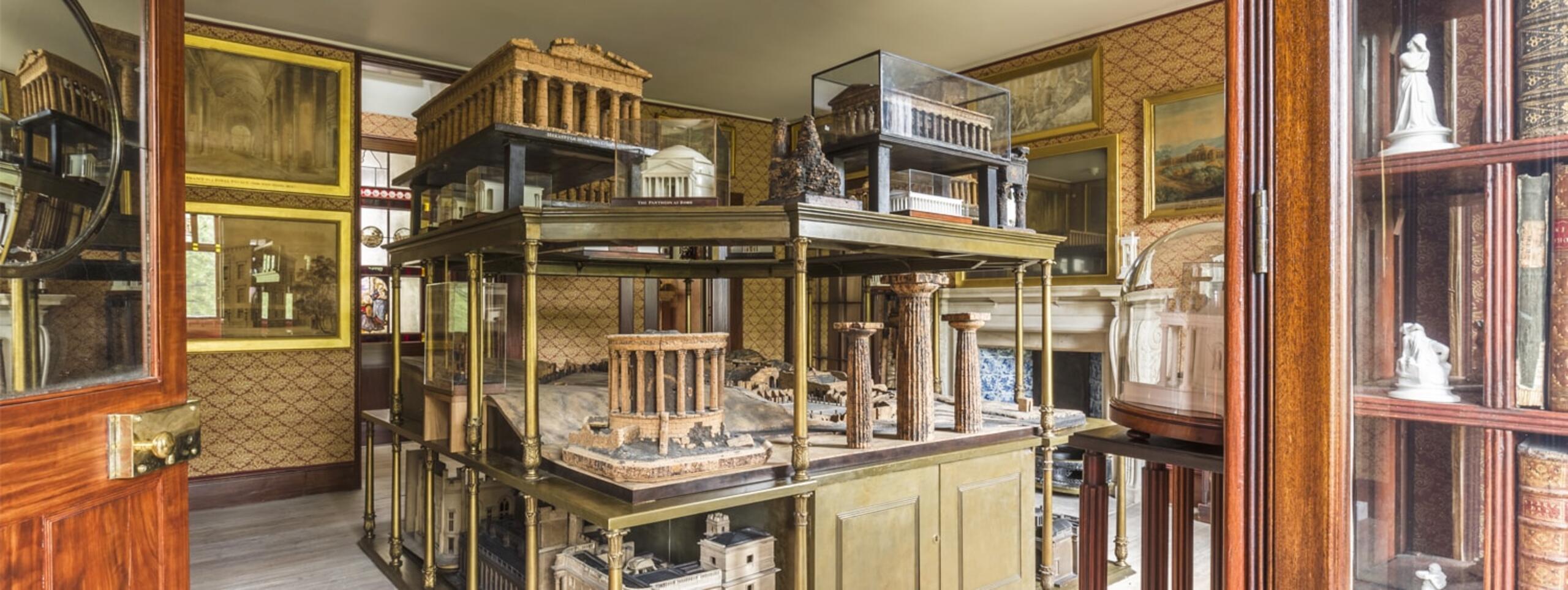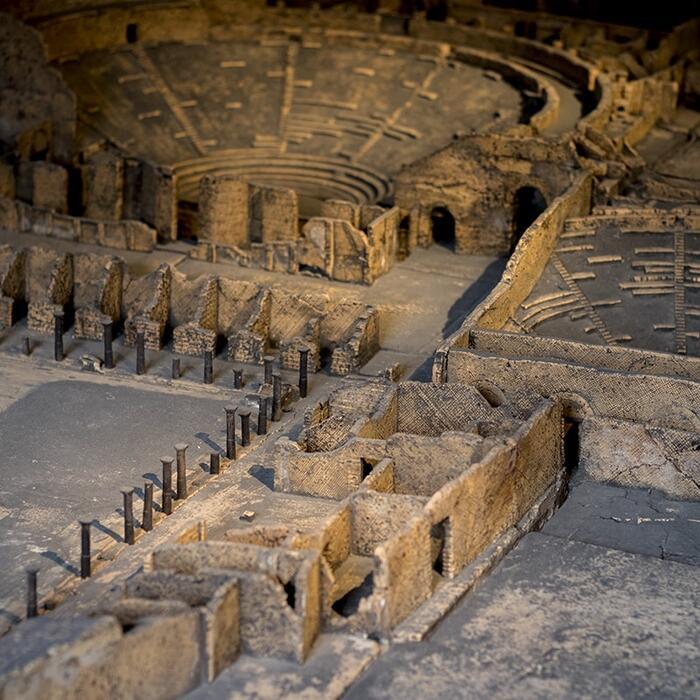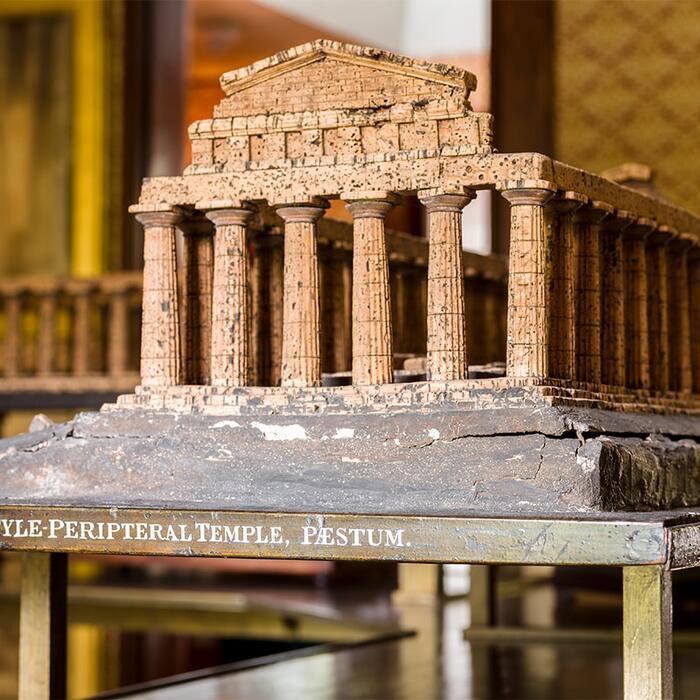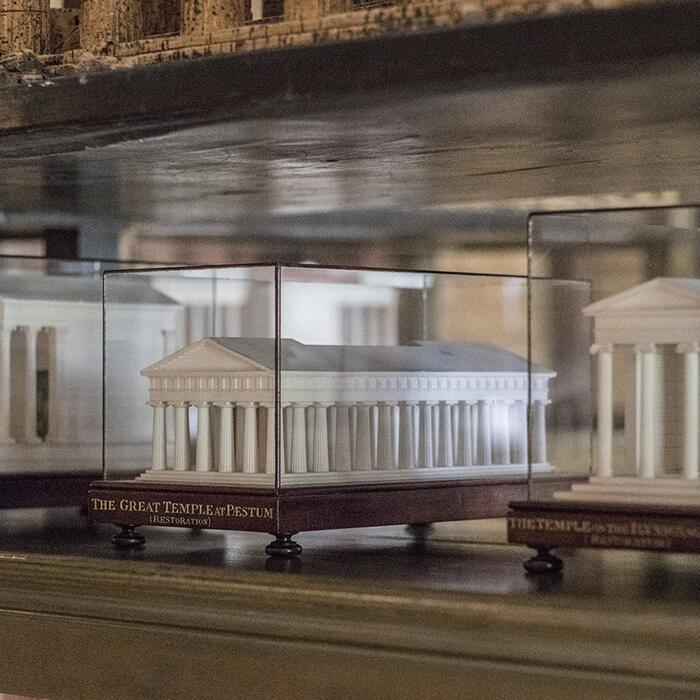One of Sir John Soane’s final additions to his Museum, the Model Room contains a display of cork and plaster architectural models depicting some of the most famous monuments of the ancient world, as well as Soane’s own building projects.
Located in the Private Apartments, the Model Room is only accessible by joining one of our tours, either a Highlights and Private Apartments Tour, which covers the entire Museum, or one of our volunteer-led Private Apartments Tours.
A Grand Tour in Miniature Back to top
In 1776, the 23-year-old Soane, an architecture student at the Royal Academy, won the Royal Academy gold medal for his design for a Classical Triumphal Bridge. This would prove a pivotal moment in his life, leading to him receiving a bursary to embark on a Grand Tour, a trip across Europe that was something of a rite of passage amongst the British elite. Soane’s visits to the ruins of opulent Classical temples across Italy – Rome, Pompeii, and Paestum, to name a few – would provide inspirations for his designs throughout his career.
Later in life, Soane amassed a collection of architectural models of sites he visited on his Grand Tour, for the benefit of the pupils training as architects in his office, and for the students of architecture he taught at the Royal Academy. These models were assembled first in the attic of the Museum, before in 1834, just three years before his death, he arranged some of these models in the old bedroom of his late wife Elizabeth.
Cork Model of Pompeii Back to top
This sprawling topographic model, covering just under 8 square feet, depicts a section of the excavations at the Roman city of Pompeii. Famously buried beneath volcanic ash by the eruption of Mount Vesuvius in AD 72, Pompeii was a source of fascination to British architects seeking to revive the architecture of the Classical world.
Made by the model-maker Domenico Padiglione, the model depicts the southernmost segment of the Roman city as it was whilst still being excavated in the 19th century – the area covered by the model is only a small piece of the area excavated today. Visible on the model are the Grand Theatre, and the Quadriporticus, a large monumental structure thought to have been an exercise field.
Temples at Paestum Back to top
Though an important source of Classical culture, Greece, then part of the Ottoman Empire, was largely off the map to Grand Tourists during Soane’s era. Architects such as Soane experienced the Greek-style Doric Temple primarily through Greek colonial settlements in Italy, such as the temples of Paestum. Paestum clearly fascinated Soane, who discussed the site in his lectures as a Professor of Architecture at the Royal Academy, and owned a number of drawings of the site by Giovanni Battista Piranesi. These cork models, again by Domenico Padiglione, uses the naturally weathered surface of cork to evoke the crumbling stone of the ancient ruins.
Plaster of Paris models by François Fouquet Back to top
In stark contrast to the crumbling cork of Padiglione’s models, these delicate and incredibly finely-detailed plaster of Paris models were constructed by the French master model-maker François Fouquet.
Where the cork models depict Classical ruins as they were in Soane’s day, the Fouquet models imagine how they may have looked in the ancient past. One of the models depicts a temple at Paestum, allowing direct contrast with the cork Padiglione models; a number of other famous buildings are also present, notably the Temple of Vesta at Tivoli, one of Soane’s favourite Roman buildings, topped with a rather fanciful pine cone.
Reproductions of the Fouquet models are available on our online shop.
Restoring the Model Room Back to top
Outside of the spaces protected by the Act of Parliament that created the Museum, and lived in by early Curators, the Private Apartments including the Model Room were gradually lost, converted into offices over the nineteenth and twentieth centuries.
From 2011 to 2016, a major conservation project restored the Private Apartments, including the Model Room, to how they were upon Soane’s death in 1837. Read more about the Opening up the Soane project.
Explore a 3D scan of the Model Room and the Museum online
Today, you can view the Model Room online as a 3D scan through our digital platform Explore Soane.
Book a Highlights Tour Back to top
Want to learn more about Sir John Soane and the artefacts he collected? Our Highlights Film takes you on a tour of the most special parts of the Museum and Sir John Soane's collection.
Visit the Museum
Entry to the Museum is by free, Wednesday to Sunday, 10am to 5pm. To visit the Model Room and Private Apartments, you will need to join one of our tours. Plan your visit here.



